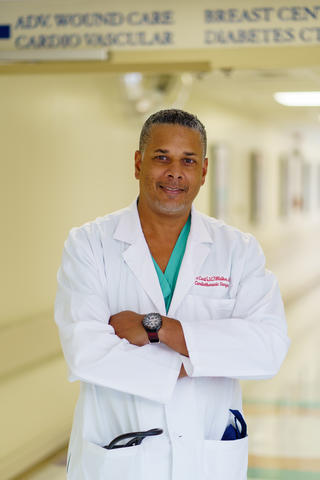Medical Director of Cardiothoracic and Vascular Surgery at St. Joseph Medical Center Encourages Diagnosis and Treatment for Peripheral Arterial Disease and Varicose Veins

Lower extremity peripheral arterial disease (PAD) affects almost nine percent of people in the U.S. and more than 30 million Americans suffer from varicose veins, according to the Centers for Disease Control. The symptoms of and treatments for these two conditions were presented by Jon-Cecil Walkes, M.D. at the recent 6th Annual Women’s Heart Luncheon at St. Joseph Medical Center.
Walkes is board certified in cardiothoracic surgery. He is the medical director of cardiothoracic and vascular surgery at St. Joseph Medical Center and also serves as the director of the hospital’s Wound and Limb Salvage Program. He told attendees that PAD encompasses all arterial diseases outside of the heart and involves the arteries supplying blood to the brain, limbs and internal organs.
“PAD is more common in the legs and occurs with the narrowing or blockage of the vessels that carry blood from the heart to the legs,” said Walkes. “It is primarily caused by the buildup of fatty plaque in the arteries, which is called atherosclerosis.”
Atherosclerotic disease in the legs is commonly accompanied by the same disease in the heart and the brain, so persons with PAD have a very high risk of cardiovascular events, including heart attack and stroke. Walkes said that PAD is a very serious disease and that it has a higher mortality rate than breast cancer.
Particularly strong risk factors for developing PAD are smoking and diabetes. Other risk factors are high blood pressure, cardiovascular disease and chronic kidney disease. Older men and women are equally affected by PAD and African-Americans have an increased risk.
“More than 80 percent of patients with PAD are current smokers or have a long history of smoking,” said Walkes. “Smoking increases the risk of developing PAD four-fold, and smokers are at risk for getting the disease an average of 10 years earlier than nonsmokers with PAD. They will also have more severe PAD and that can double their risk of amputation.
Walkes said given the severity of the disease, it is not surprising that smokers with PAD have worse survival rates than nonsmokers with PAD.
Symptoms and signs of PAD
The major symptom of PAD is pain in the legs with exertion, like walking, that resolves quickly with rest. For those with PAD, pain, aching, fatigue or cramping while walking can occur in the buttocks, legs or feet and it is called claudication. Unfortunately, more than 50 percent of patients do not have classical signs or symptoms of the disease because they may not perform a sufficient amount of activity to produce them. These patients will still show subtle impairments in limb function that become evident with any activity.
Walkes said there are additional physical signs of PAD that include smooth shiny leg skin or skin that is cool to the touch, thickening of toe nails, non-healing ulcers, or decreased pulses in the feet.
“It is important that persons experiencing any of these signs or symptoms see their physician as soon possible. There are noninvasive diagnostic tests that can be done,” advised Walkes.
The American Heart Association, as well as the American College of Cardiology, recommends testing for all patients at high risk, including those over age 70, over age 50 with a history of smoking or diabetes, under 50 with diabetes, or those with a history of cardiovascular disease or kidney disease.
Walkes stated that patients with PAD must consider lifestyle modifications, including smoking cessation, blood pressure and diabetes control, weight reduction, exercise and changes in diet.
“There are medications and surgical treatments for PAD, but the medical community highly recommends starting with changes in lifestyle,” said Walkes. “About five percent of patients undergo amputation and less than half of them regain the ability to walk. They also have increased risks of cardiovascular events and limb infections.”
Venous disease and varicose veins
Walkes explained that the arteries carry blood from the heart to the rest of the body, and it is veins that carry blood back to the heart. Healthy leg veins contain valves that keep blood moving in one direction back to the heart. Venous reflux develops when the valves become damaged or diseased.
“Venous reflux disease is a progressive medical condition and if left untreated, may worsen over time and develop into a more serious form called chronic venous insufficiency, or CVI, that results in the pooling of blood in the veins of the legs,” said Walkes. “Most commonly, this is caused by blood clots and varicose veins.”
Only about two million persons, of the 30 million Americans affected with CVI, seek treatment. There is a significantly higher prevalence in women, and those who have had one or more pregnancies. Among the many factors that contribute to CVI are family history of venous diseases, old age, an occupation that requires standing for long periods of time, obesity and lower limb trauma or surgery.
Patients who suffer from CVI may have symptoms of leg pain, leg heaviness and fatigue, restless legs, burning or itching of the skin, leg or ankle swelling, varicose veins and skin changes.
Diagnosis of CVI is done with an ultrasound study and there are several conservative therapies that can treat symptoms, like leg elevation and wearing compression socks. Non-surgical treatments include endovenous ablation, which uses radiofrequency or laser energy to cauterize and close varicose veins in the legs. It is popular for cosmetic purposes, and also commonly used to ease the symptoms of CVI.
According to Walkes, there are several other treatments available that provide relief of symptoms within a few days, so he encourages individuals to talk to their physicians about any leg discomfort they may be experiencing.
For more information about the cardiothoracic services available at St. Joseph Medical Center, visit the website at sjmctx.org.
